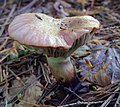Taxonomy
Elias Magnus Fries initially described the genus as Agaricus subgenus Gomphus in 1821, before renaming it Gomphidius in 1825.
The genus gives its name to the family Gomphidiaceae. Despite being agaricoid (bearing gills) the genus (and family) belong to the Boletales (suborder Suillineae). [3] The related genus Chroogomphus (whose species were once classified in Gomphidius), is distinguished by the lack of a partial veil.
The genus name is derived from the Greek 'γομφος' gomphos meaning 'plug' or 'large wedge-shaped nail'. [4]
Fries did not designate a type species, but G. glutinosus was later designated the lectotype as it was the first species listed. [5]
Miller subdivided the genus into three sections, section Microsporus, typified by small spores, with G. oregonensis as the type, section Roseogomphus, typified by large spores and pink cap, with G. subroseus as its type, and section Gomphidius. [5]
Miller published a molecular analysis of the Gomphidiaceae in 2003, though material was not available from all taxa. The results showed G. flavipes and G. pseudoflavipes were sister taxa and their lineage was sister to a Japan-provenance material of G. roseus. G. glutinosus and G. oregonensis were sister taxa with G. smithii, G. subroseus and G. nigricans as progressively earlier offshoots. G. maculatus diverged from the ancestor of these eight species, and Gomphidius borealis may be an early offshoot that is basal to the split between Chroogomphus and Gomphidius. [6] Miller suggested that the gasteroid species Gomphogaster leucosarx may lie within Gomphidius but did not analyse that taxon genetically. [6]
This page is based on this
Wikipedia article Text is available under the
CC BY-SA 4.0 license; additional terms may apply.
Images, videos and audio are available under their respective licenses.








